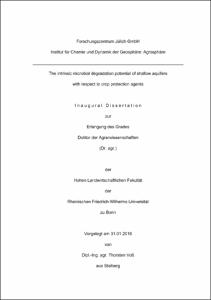Voß, Thorsten: The intrinsic microbial degradation potential of shallow aquifers with respect to crop protection agents. - Bonn, 2010. - Dissertation, Rheinische Friedrich-Wilhelms-Universität Bonn.
Online-Ausgabe in bonndoc: https://nbn-resolving.org/urn:nbn:de:hbz:5N-21909
Online-Ausgabe in bonndoc: https://nbn-resolving.org/urn:nbn:de:hbz:5N-21909
@phdthesis{handle:20.500.11811/4214,
urn: https://nbn-resolving.org/urn:nbn:de:hbz:5N-21909,
author = {{Thorsten Voß}},
title = {The intrinsic microbial degradation potential of shallow aquifers with respect to crop protection agents},
school = {Rheinische Friedrich-Wilhelms-Universität Bonn},
year = 2010,
month = aug,
note = {Active substances in crop protection agents are assessed by a community procedure, and a comprehensive dossier including data and tests is part of the application. The studies must be performed according to specified standards and by certified testing facilities. Recently, it is discussed, whether it is necessary to extend these tests to aquifers to investigate the environmental behaviour of CPA in the groundwater. This was the main motivation to develop a dynamic artificial aquifer incubation system (DAISY) at the lab-scale for standard use. DAISY is operated fully automated via online control at different redox conditions, and it is possible to simulate different groundwater flow rates. This is important, as I showed that dynamic flow conditions generally increase the degradation kinetics of the model compound benzoic acid, an effect that can also be assumed for the degradation of other aromatic substances. A test system is now available that enables to study the intrinsic microbial degradation potential of shallow aquifers at realistic low concentrations of ≤ 10 μg l-1.
As part of the work I conducted, I compiled important information on the design of future groundwater studies. Benzoic acid was used to investigate processes relevant to degradation within the scope of developing a static and dynamic test system. It was shown that simple physical parameters, such as the dynamic solubility of carbon dioxide in water, were not taken into account in groundwater studies in the past.
The test systems developed within the scope of this work were also used to investigate the current intrinsic degradation potential of three shallow aquifers for Imidacloprid, Isoproturon and Diketonitrile. In various long-term incubation studies, a general degradation potential was assessed under oxygen-, iron-, and sulphur-reducing conditions and at a concentration of 0.1, 1, and 10 μg l-1. It was revealed, however, that the lower mineralization rates led to accumulation of metabolites becoming the most important parameter for estimating the degradation potential at a concentration of ≤ 10 μg l-1.
The intrinsic degradation potential of the aerobic shallow aquifers was analysed in enrichment cultures, for which a variety of carbon sources were available. The microorganisms metabolised Isoproturon as both the only carbon source as well as co-metabolically. This was accompanied by an increase in the microbial biomass. Furthermore, using fingerprint techniques (DGGE) a strong displacement of the microbial population was confirmed. The experimental approach has good potential to isolate future bacterial strains with a specific degradation potential for individual CPA.},
url = {https://hdl.handle.net/20.500.11811/4214}
}
urn: https://nbn-resolving.org/urn:nbn:de:hbz:5N-21909,
author = {{Thorsten Voß}},
title = {The intrinsic microbial degradation potential of shallow aquifers with respect to crop protection agents},
school = {Rheinische Friedrich-Wilhelms-Universität Bonn},
year = 2010,
month = aug,
note = {Active substances in crop protection agents are assessed by a community procedure, and a comprehensive dossier including data and tests is part of the application. The studies must be performed according to specified standards and by certified testing facilities. Recently, it is discussed, whether it is necessary to extend these tests to aquifers to investigate the environmental behaviour of CPA in the groundwater. This was the main motivation to develop a dynamic artificial aquifer incubation system (DAISY) at the lab-scale for standard use. DAISY is operated fully automated via online control at different redox conditions, and it is possible to simulate different groundwater flow rates. This is important, as I showed that dynamic flow conditions generally increase the degradation kinetics of the model compound benzoic acid, an effect that can also be assumed for the degradation of other aromatic substances. A test system is now available that enables to study the intrinsic microbial degradation potential of shallow aquifers at realistic low concentrations of ≤ 10 μg l-1.
As part of the work I conducted, I compiled important information on the design of future groundwater studies. Benzoic acid was used to investigate processes relevant to degradation within the scope of developing a static and dynamic test system. It was shown that simple physical parameters, such as the dynamic solubility of carbon dioxide in water, were not taken into account in groundwater studies in the past.
The test systems developed within the scope of this work were also used to investigate the current intrinsic degradation potential of three shallow aquifers for Imidacloprid, Isoproturon and Diketonitrile. In various long-term incubation studies, a general degradation potential was assessed under oxygen-, iron-, and sulphur-reducing conditions and at a concentration of 0.1, 1, and 10 μg l-1. It was revealed, however, that the lower mineralization rates led to accumulation of metabolites becoming the most important parameter for estimating the degradation potential at a concentration of ≤ 10 μg l-1.
The intrinsic degradation potential of the aerobic shallow aquifers was analysed in enrichment cultures, for which a variety of carbon sources were available. The microorganisms metabolised Isoproturon as both the only carbon source as well as co-metabolically. This was accompanied by an increase in the microbial biomass. Furthermore, using fingerprint techniques (DGGE) a strong displacement of the microbial population was confirmed. The experimental approach has good potential to isolate future bacterial strains with a specific degradation potential for individual CPA.},
url = {https://hdl.handle.net/20.500.11811/4214}
}






